What the orchid roots tell us
An article with this title appeared in an orchid magazine in the mid-1970s. At that time, it was already formulated somewhat provocatively whether we orchid cultivators are not trying hard enough to get to know our plants properly, or whether we are simply not applying our knowledge. Do we belong to a society that perhaps no longer teaches us to take a close look at something, let alone see and understand certain processes? You expect ready-made recipes everywhere and do without logical thinking.
It is strange that a society which cultivates orchids, and which has been taught the concept of photosynthesis in relation to the green component of the leaves and the necessity of light for the production of plant matter, should spend so much time trying to grow green and so Potting chlorophyll root tips into pots of planting matter - why?
Nature rarely wastes anything unnecessarily, so we have to assume that the chlorophyll in the roots has a special function. In America, experiments with green tissue from different parts of orchid plants found that the chlorophyll in the root tips assimilated 6 to 36 times more efficiently than the chlorophyll in the leaves at the same amount. The extent to which transparent planters can support this effect of the roots is often tried out.
In epiphytic orchids, about 3 to 4 centimeters behind the green root tip is the so-called velamen, in which the cells have lost their active cell content. The outer layer of the velamen is white, so it reflects light and heat. This is reasonable because many orchids live in extremely hot climates and are exposed to direct sunlight from time to time, which would dry out the active part of the roots if not protected.
root of phal. violacea in bark substrate
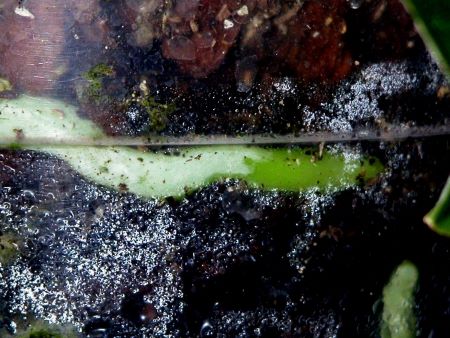
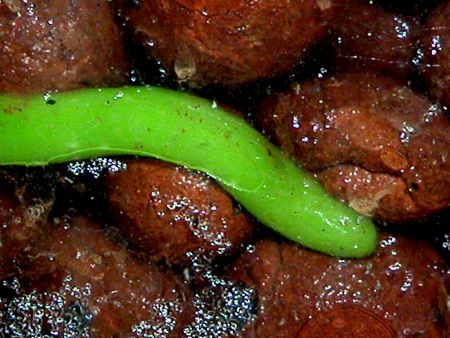 Root of Phal. violacea in the permanently moist semi-hydro substrate
Root of Phal. violacea in the permanently moist semi-hydro substrate
Underneath the velamen lies a unicellular layer of healthy cells, separating them from the exodermis, which is made up of healthy cells. From here, the water reaches the central cylinder of the root and can thus be transported into the plant with the transpiration stream and via osmotic pathways. The empty cells of the velamen can act like a sponge and absorb water when the root gets rainwater or moisture in the form of mist. The Velamen now appears greenish for a short time. For a long time it was assumed that the moisture could be retained as a reservoir. This is doubtful, because we now know that the Velamen dries up quickly. It is more likely that the moist cells of the velamen, in addition to providing the plant with water and nutrients, act like the hairs on a leaf in containing a supply of moist air for root cooling. This means that the root is well protected from the intense sunlight of the next day.
You can read again and again that an orchid can only be as good as its root system. It is noticeable that root growth can proceed very quickly and then the shoot slows down its growth or even stops for some time. Targeted nutrition of the active root can ensure that the active metabolites from the leaves are more easily beneficial to the shoot and ultimately to the formation of flowers.
Even when the orchids are dormant, it is advisable to apply a light root fertilization with spray mist, which can then also be regarded as foliar fertilization.
Fortunately, orchid roots can adapt to the respective culture conditions or substrates - however, they have to grow into the respective substrate independently. In its natural habitat, roots have also been found in water, e.g. in flood plains or in the funnels of bromeliads.
the root grows into the water reservoir in a glass culture
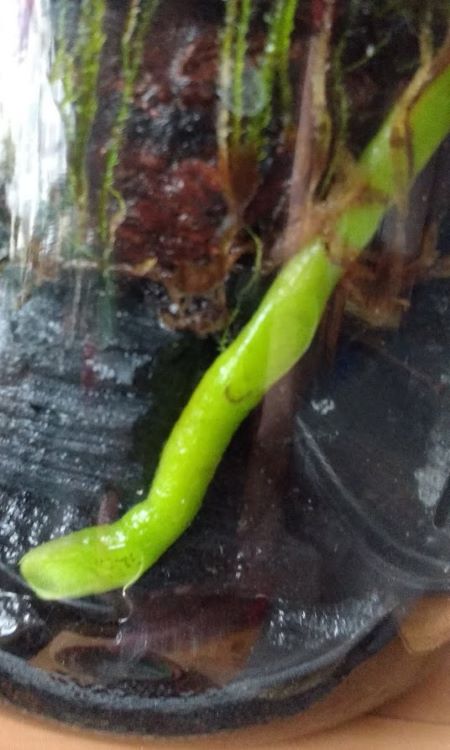
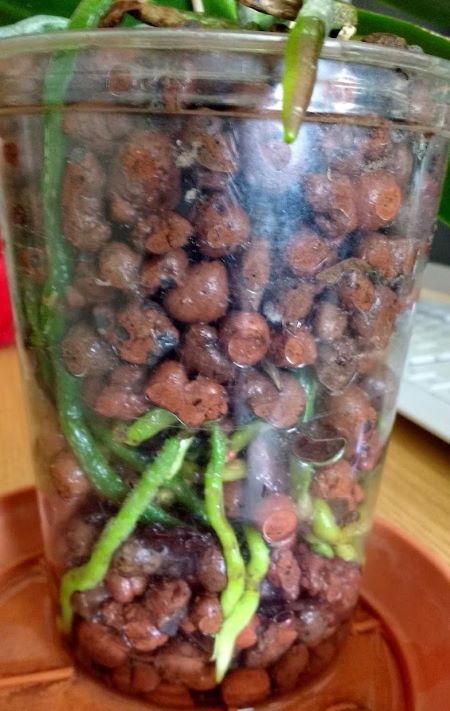 in semi-hydroponics roots grow into the water
in semi-hydroponics roots grow into the water
Anyone who has already seen orchids at the site is always impressed how large orchids can grow there. But where do the nutrients that are necessary for the lush growth of plants come from?
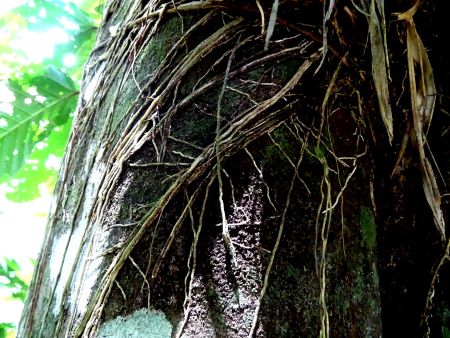
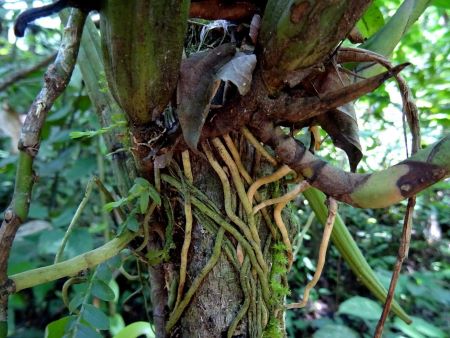
One of the most frequently heard explanations says that atmospheric nitrogen is split by lightning discharges during thunderstorms and converted into nitrogen oxides, which are then dissolved in rainwater and are then available to plants.
Under the direction of Dr. Zoe Lindo of McGill University, researchers have found that in the canopy of old trees, large amounts of nitrogen compounds are produced by cyanobacteria that live in mosses in the trees. But mosses, lichens and algae can also use light as an energy source to produce their own food from nitrogen and carbon from the atmosphere. Of course, the same also applies to mosses, algae and lichens on rocks and rocks. It is known from lichens that they can dissolve rocks with their own excretions so that other plants are then available as nutrients with the next rain.
Certain microorganisms that can fix nitrogen from the air have been found on or in the cells of the lamellar roots of epiphytic orchids. If the roots are now moistened by rain or condensing humidity, this nitrogen is dissolved in water and sucked up by the velamen like a sponge and finally penetrates to the central cylinder and nourishes the orchids.
Intensive agriculture can result in high levels of nitrate pollution, especially in groundwater, which can then lead to problems in drinking water production. For this reason, alternatives in the fertilization of crops have been researched. As a result, nitrogen-fixing bacteria have been found which can also fix the nitrogen in the air. These bacteria have been cultured and solubilized so that they can be applied to the foliage of plants. In individual cases, yield increases of up to 40 percent have been found.
For test purposes, I sprayed these bacteria from the products Poesie and BlueN on my orchids and after about two weeks I was able to see the first successes in growth - imagination? Reliable statements will probably only be possible after a cultural period.
The substrates for our orchid cultures have changed a lot in the last few decades. Fern roots, Xaxim and tree ferns have long been unavailable, partly because of the conservation of these materials. As a first alternative, orchids have long been planted in peat, but moors as a source of peat are also protected today.
In recent years, bark from various trees has therefore been offered as a planting material for orchids and has also proven itself. When cultivating, it is important to note that at the beginning of the culturing period, the bark is still protected by the resins it contains and is only later slowly decomposed by microorganisms. This allows the bark to store more water after a few months and we have to water less. If you ignore this fact, the orchid roots can rot quickly. It is therefore helpful to repot all of your orchids at the same time.
Little attention is also paid to the fact that most types of bark have a relatively low pH of around 4.5. This is too low for many orchid species (especially Paphiopedilum) and the roots can die off quickly. The gardeners therefore added carbonate of lime (calcium carbonate) to the bark substrates to raise the pH value.
We orchid lovers should also add lime to the bark substrate every few months to buffer the pH value in this substrate.
Paphiopediles in particular need lime in the planting material
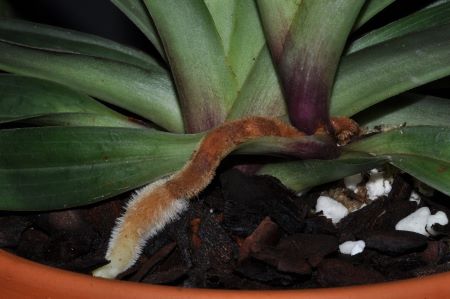
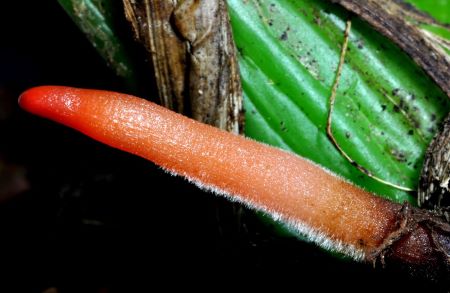 a fine hairiness even with a coelogyne
a fine hairiness even with a coelogyne
Rainwater or osmosis water should always be used as irrigation water in the orchid culture, as it has a low conductivity. Tap water usually has a conductance value that is too high and the pH value, at well over 7.0, is also much too high for orchid culture. A mixture of three parts rainwater and one part tap water is beneficial for irrigation water for the orchids. If the plants are to be fertilized, it is better to use rainwater.
Experiments in my orchid greenhouse have shown that most orchid roots are sensitive to high conductivity and pH values. The green root tips retreat quickly when the orchids are sprayed or watered with a conductance greater than 250 µS. The pH should be around 6.0. In this area, almost all nutrients can be absorbed by the plants. These values apply in particular to the so-called "aerial roots", which are rarely found in nature. In the substrate, the roots are better protected against conductivity and pH fluctuations and can therefore tolerate a slightly higher fertilizer concentration.
good rooting in expanded clay (semi-hydro) of a Stonelaelia
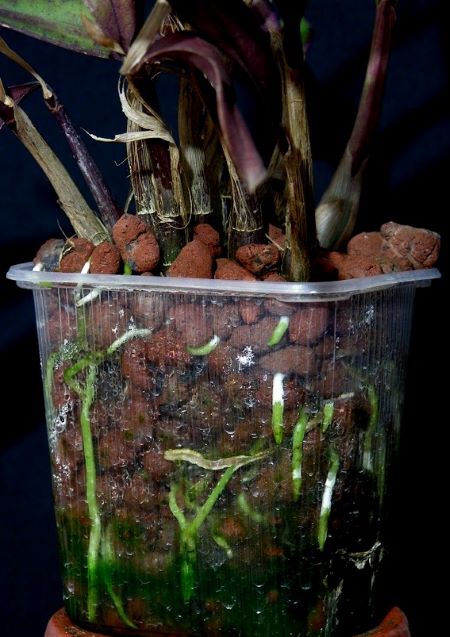
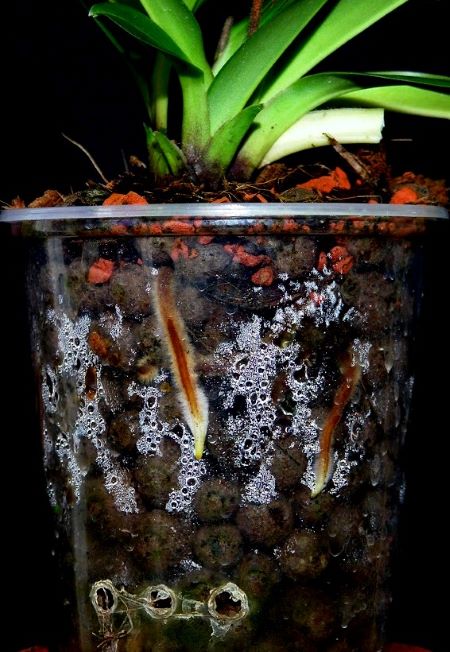 good rooting of Paphiopedilum in semi-hydro
good rooting of Paphiopedilum in semi-hydro
In their natural habitat, orchid roots primarily serve to anchor the plant in the respective substrate, regardless of whether it is an epiphytic or terrestrial orchid. However, the active root tips are always on the lookout for nutrients.
However, most orchids with many “aerial roots” can be seen on the windowsill at home. The roots prefer to grow into the air rather than into the planting matter. This is mainly due to the fact that the plant material is completely salty due to the regular use of tap or fertilizer water. It is precisely the substrate surface that stores these salts after the water has evaporated and thus has a toxic effect on the orchid roots. Even regular rinsing with rainwater or distilled water hardly helps. Regular repotting of the orchid in fresh substrate alone will have a positive effect on root growth. In the meantime, the top layer of the substrate could be replaced regularly.
In nature, no salts can accumulate in the substrate due to the regular rule falls. During measurements at the natural site in Mt. Kinabalu Park at an altitude of 1700 meters (Sabah, Malaysia, Borneo), I caught the water running down on a tree shortly after it started raining. The conductance was 125 µS at the beginning of the rain, after half an hour only values of 25 µS could be measured. The velamen of the on-site orchids soaks up to saturation immediately after the onset of rain with the slightly nutrient-rich water. This behavior of the root should also be taken into account in the domestic culture.
The orchid root can grow in all directions in search of food. If the root grows freely on a branch or rock, the green root tip and the whitish verlamen are clearly visible. However, if the root then reaches an accumulation of humus or moss, the appearance of the root changes and fine root hairs can form. This means that the few nutrients are optimally absorbed and can be used well. This was only known to me from the paphiopediles, but the attached pictures show this effective method of feeding other orchids as well. If there is too much heat in the culture room or high fertilizer doses, these fine root hairs disappear in a short time
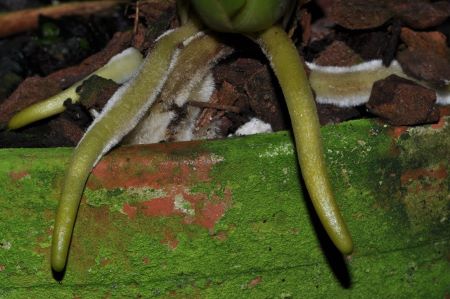

Certain nutrients are important for a good growth of our orchids in our crops. So far it has been assumed that at least the main nutrients nitrogen (N), phosphorus (P), potassium (K) and certain trace elements are necessary. Recent research and publications, e.g. by Dr. Wolfgang Ermert have now shown that calcium and magnesium in particular are very important for orchid nutrition. It is surprising that calcium in particular has now been recognized as the most important nutrient element for all orchids.
Most fertilizers or orchid fertilizers do not contain calcium. In order to ensure that the orchids have the calcium they need, they should be watered regularly with nitrate of lime (e.g. calcinit) - but never together with another fertilizer! The calcium would then react with other nutrients (particularly phosphorus) and would then no longer be available to the plants as a nutrient. Although most tap water contains not inconsiderable amounts of calcium, this lime is not available to orchids because of chemical reactions with other salts.

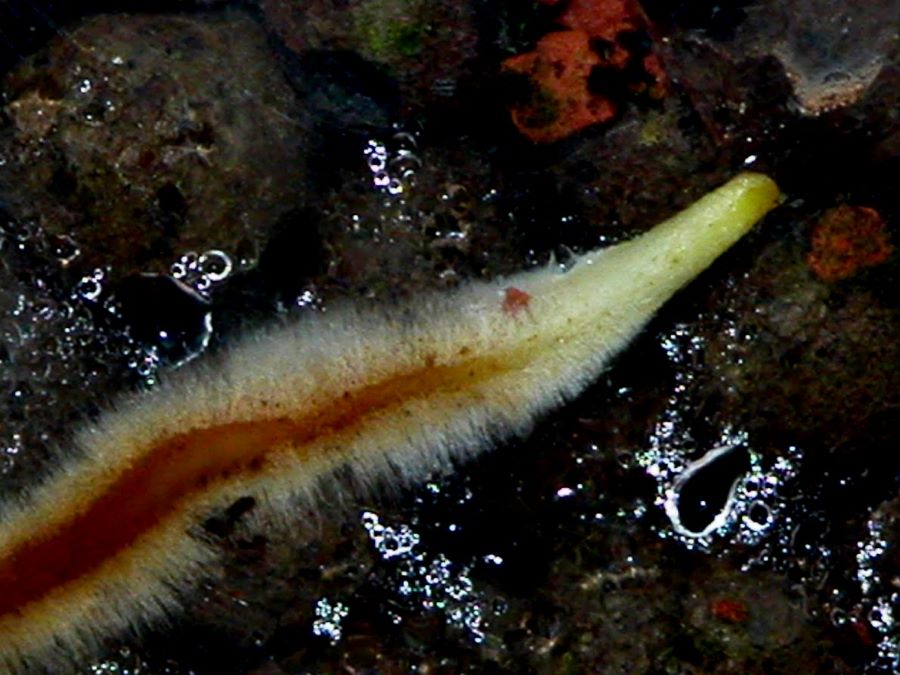
Roots of Paphiopedilum in search of nutrients
Finally, noteworthy tips for orchid culture:
-
If the green root tips of the orchids are no longer than 1 cm during growth, then the growing conditions can be improved. Try more moisture, a little more heat, and a lower fertilizer concentration.
If the new roots look like a string of sausages with thick and thin spots, then the culture method is uneven. Provide more humidity in the air and less in the pot.
-
If the green root tip stops growing as soon as it hits the soil surface, then the salt or acidity in the top layer of soil is more than the plant can tolerate. Now think about repotting - at least the top 3 cm of the planting material has to be exchanged.
If a new growing root tends to attach itself to the outside of the pot or basket, encourage it as long as it's not too much trouble. Orchid roots seem to perform much better when attached to a solid surface.
-
If potted orchids prefer to let the majority of their roots grow into the air rather than into the potting matter, consider a basket or cork the next time you transplant them.
They cannot exactly imitate the natural conditions in the respective cultivation area of their orchids. So evaluate the tolerance of the roots using your own observations and common sense.
-
Always pay attention to what "the plant tells you through its roots".


